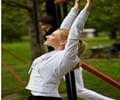New research indicates that children living in a neighborhood designed with a special bike trail were more likely to get vigorous physical activity.

Researchers compared two low-income neighborhoods in Chattanooga, Tenn. One had a "new urbanist construction" that features a specially-designed, two-mile, extra-wide trail/sidewalk for biking and walking that winds from new public housing and single-family residences to a school, library, recreational facility, park and retail shops. The other area has traditional homes, public housing, a new school, park and an older, regular-width sidewalk.
"There was more vigorous activity in the park and along the trail," said Gregory W. Heath, D.H.Sc., M.P.H., the study's lead author and assistant provost for research and engagement at the University of Tennessee at Chattanooga and the UT College of Medicine. "There was more jogging or bike riding, which makes sense because the urban trail was made for that."
In previous studies on this type of community feature, researchers focused mostly on suburban or upper-income neighborhoods, Heath said.
"Infrastructural changes like these are expensive," said Heath, who is also professor of health and human performance and medicine. "But quite frankly in the long run, they're worth it."
 MEDINDIA
MEDINDIA




 Email
Email










